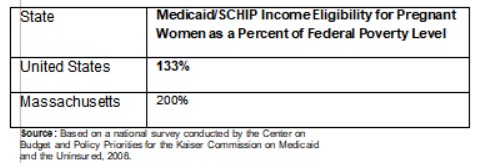Reproductive Health Disparities in Massachusetts
Beginning to understand health disparities and their causes can seem vague or overwhelming. The following data, adapted from an analysis of national data done by the Kaiser Family Foundation, gives an idea of the state of reproductive health disparities by race/ethnicity in Massachusetts. Each table shows the disparity scores of the United States as a whole (“All states”) and that of Massachusetts. A disparity score greater than 1.0 indicates that minority women are doing worse than white women, i.e. disparities are present.
Low birth weight is a huge contributor to Infant Mortality (or death within the first year of life) and can have long-term health effects.
This table showing rates of low birth weight, show that Massachusetts has higher racial and ethnic disparities in low birth weight than the national average. We can also see that black women in the state of Massachusetts have the highest rate by far of low birth weight (11.8%) compared to other groups, although this rate is below the national average for black women (13.8%).

Good prenatal care helps mom and baby to have a healthy pregnancy and birth.
This table shows rates of late initiation of or NO prenatal care. We can again see that the disparity score in this area for Massachusetts (at a very high 2.18) is higher than the national disparity score. Black women have the highest rate of inadequate prenatal care at a substantial 20%, almost three times the rate for white women (7.6%).

Pap tests are considered to be essential in the early diagnosis and treatment of cervical cancer.
This table shows the rates of women who have NOT had a pap test in the last three years. In this case, the disparity score for Massachusetts (2.08) is much higher than the national score (1.27), indicating greater disparities. Asian and Native Hawaiian/Pacific Islander women in the state of Massachusetts had the highest rate of no recent pap test (22.2%) and Hispanic women had the second highest rate (16.6%). These rates indicate some shortcoming in the health care system of Massachusetts to get women screened for cervical cancer.

Poverty can influence many aspects of a woman´s health, from nutrition to environmental hazard exposure.
We can see in this table that Massachusetts again has a higher than average score for racial and ethnic disparities in the area of poverty(2.55), although the national score is also very high (2.18). All three minority groups listed, black women, Hispanic women, and Asian women, all have much higher rates of poverty than white women. These data show that minority women are disproportionately affected by poverty in Massachusetts. This disproportionate rate of poverty is likely to translate into a disproportionate burden of health problems, which will only worsen their state of poverty.

Family Planning Funding can help women take control of when and how they reproduce. On average, women with incomes less than 250% of the Federal Poverty Level are eligible to receive $149 for family planning services. In Massachusetts, this figure is only a little lower at $143.

There are some areas in which Massachusetts is doing better than other states to take care of minority and low-income women.
One of these areas is the threshold income for pregnant women that Massachusetts requires for Medicaid and SCHIP benefits. While the United States requires coverage only for pregnant women with an income under 133% of the Federal Poverty Level, Massachusetts provides benefits for women with incomes up to 200% of the Federal Poverty level, meaning that Massachusetts provides more low-income women with benefits than is required nationally.

